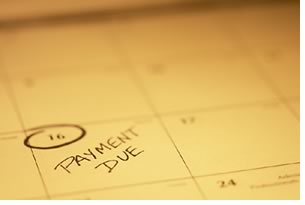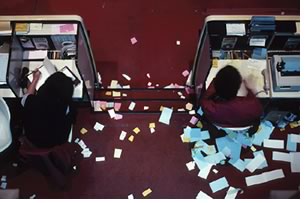

04/2005
Basic documentation requirements

by Grant A. Simpson, FAIA, and James B. Atkins, FAIA
Many architects think of documentation as an irritation that encroaches on their design efforts. They view documentation as a task of drudgery forced on them by the “technical guys” or the “lawyers.” Actually, documentation is as integral to architecture as are sketchbooks, renderings, construction drawings, and change orders. It is not a new concept, as history reveals that Leonardo da Vinci kept detailed notebooks in the 14th century.
 The review of documentation in this article ranges from simple, handwritten “to-do
lists” kept only for the purpose of organizing one’s workday
to more complex contracts that have significant legal implications. All
of these forms of documentation with which architects interact and are
required to create, manage, and maintain form a necessary part of the
culture and practice of architecture. For some architects, documentation
is a naturally occurring habit; for others, it is a burden that is often
resisted and sometimes avoided altogether.
The review of documentation in this article ranges from simple, handwritten “to-do
lists” kept only for the purpose of organizing one’s workday
to more complex contracts that have significant legal implications. All
of these forms of documentation with which architects interact and are
required to create, manage, and maintain form a necessary part of the
culture and practice of architecture. For some architects, documentation
is a naturally occurring habit; for others, it is a burden that is often
resisted and sometimes avoided altogether.
Over the past quarter century, the sheer quantity of documentation generated through the design process has grown significantly. Projects that required only a few file boxes in the 1980s result in many times that amount today. Documentation has become a time-consuming endeavor in the design and construction process that must be understood and managed.
A management tool
Effective documentation habits are a necessary and valuable management
tool, and the sometimes perilous path to a successful project always
requires good solid project management. Moreover, good project management
always requires clear communication and careful coordination. From
concise contracts that define the obligations of the parties involved
in a project to meeting agendas and meeting notes that facilitate effective
project meetings, documentation is the essential fabric of project
management.
 The
most effective managers develop personal documentation habits that incorporate
it into their daily work. Documentation is not drudgery to them because
it is essential to the way they manage their projects. Writing a meeting
report, making handwritten notes, or sending a client a contract proposal
becomes second nature to their design activities. On the other hand,
attending a meeting without an agenda, or making a site visit without
preparing a field observation report creates angst for the effective
manager. This is counter to the smooth flow of communications and information
on a successful project more so than concerns about risks.
The
most effective managers develop personal documentation habits that incorporate
it into their daily work. Documentation is not drudgery to them because
it is essential to the way they manage their projects. Writing a meeting
report, making handwritten notes, or sending a client a contract proposal
becomes second nature to their design activities. On the other hand,
attending a meeting without an agenda, or making a site visit without
preparing a field observation report creates angst for the effective
manager. This is counter to the smooth flow of communications and information
on a successful project more so than concerns about risks.
Selective amnesia
Owners sometimes forget that they have made a critical design decision,
such as authorizing the designer to proceed to the next phase of services.
Contractors have been known to forget that they have advised the designer
that a minor change in the work will have no cost or schedule impact.
Consultants can forget that they agreed to have their drawings ready
to issue by a certain date. Proactive documentation of decisions and
reminders of commitments made by team members are essential management
requirements and a definite advantage over the alternative of proving
the facts after the fact without the fax (or letter, AIA G716-2004,
or other written documentation) in hand.
 The need for tangible evidence
The need for tangible evidence
Another practical use of documentation counters more sinister activities.
It has been established that disputes and claims typically are resolved
by the most intact and explicit documentation. In short, he or she
who has the best documentation usually wins. This quantitative and
qualitative advantage of documentation in claims management has no
doubt increased the overall amount of paper that typically is generated
on a project.
During the design and construction process, many communications affecting time and cost are exchanged. Affirmative documentation, such as phase completion sign-offs, authorizations to proceed, site observation reports, meeting reports, and schedules are efficient tools of management that facilitate a more efficient and effective project delivery.
As we move closer to “paperless project” methods, such as the building information model (BIM), which consists of data manipulated through 3D parametric modeling, this need for tangible evidence by our legal industry eventually may diminish. However, for now, documentation will remain the hallmark of good project management.
Types and adequacy of documentation
Documentation can take many forms. Because it can be generated by those
who make decisions and those who react to those decisions, some forms
of documentation by necessity must be more compelling than others.
 Different individuals develop different habits for making and maintaining
documentation. Just as there are messy desks and there are clean desks,
there will be managers who produce clear pristine documentation, and
others who will keep files of ragged notes on whatever paper is at hand.
Accordingly, the range of documentation considered to be adequate varies
from almost nothing at all to an archive of properly filed and fully
executed documents. Below are a few examples.
Different individuals develop different habits for making and maintaining
documentation. Just as there are messy desks and there are clean desks,
there will be managers who produce clear pristine documentation, and
others who will keep files of ragged notes on whatever paper is at hand.
Accordingly, the range of documentation considered to be adequate varies
from almost nothing at all to an archive of properly filed and fully
executed documents. Below are a few examples.
Agreements: Contracts are the basic vehicle by which the obligations of the parties to a legal agreement are set forth. Contracts can take many forms. When given a choice, the following are listed from most preferred to least.
Most Preferred ![]()
- A fully executed AIA standard form of agreement
- A fully executed, customized agreement referencing AIA A201 General Conditions of the Contract for Construction and/or other AIA documents
- A letter of agreement referencing an applicable AIA form contract
- A confirming memorandum sent to the other party, but not signed and returned
- An oral understanding with no substantiating documentation
Least Preferred ![]()
Although recognized by law as binding in many (although not all) states, oral agreements are disputable and difficult to substantiate, due to the lack of documentation. The old joke rings true when you consider that “oral agreements aren’t worth the paper they’re written on.”
Approvals, notices and phase completion sign-offs: These are forms of documentation that can be generated by the owner, contractor or the architect. The AIA documents contain many instances where such actions are required. The preferences for these types of documents are, again listed from most preferred to least.
Most Preferred ![]()
- A formal letter acknowledged in writing by the approving party
- Confirming correspondence, letter, or e-mail sent by the party seeking approval to the approving party
- An oral notice, approval, or understanding with an oral acknowledgment
Least Preferred ![]()
Meeting Reports and Memos: Some architects do not prepare meeting reports and they believe they are a waste of time. If an architect attending a meeting does not prepare notes from his or her observations during the meeting—no matter how informal—we believe there is no justification for attending the meeting. Meeting notes are most effectively used as a project management tool if they are issued to the project team in a timely manner. Reporting need not be a burdensome endeavor and can be useful in several formats.
Most Preferred ![]()
- A formal typed report, with a list of attendees, recounting in narrative form the discussions and decisions made during the meeting—this form of report is issued with attachments of all handouts reviewed during the meeting and generally contains an “aging statement” indicating that it is assumed that the attendee agrees with the statements therein if they do not respond within a certain period of time
- A formal typed report in “Action Item” format, generally continued from a prior meeting, containing many items, with only items of new discussion documented—this form also typically contains an aging statement
- Handwritten notations, often with attendees’ initials in lieu of names, describing the discussions and decisions made during the meeting
- A memo or e-mail listing summary bullet points
- A handwritten note
Least Preferred ![]()
 As was observed in the first
article of this series, the meeting report “is essentially a tool for reporting project
progress to the owner. If you issue the report, you will be able to recount
the events as you experienced them. If you do not issue the report, you
will likely read results or opinions that do not coincide with your own.
If your contract or your project organizational structure does not allow
you to issue the project meeting report, it will be necessary for you
to rebut in writing each and every issue and event that is not consistent
with your experiences and understandings. Rebuttal is a laborious process
that too frequently falls through the cracks of a busy schedule.”
As was observed in the first
article of this series, the meeting report “is essentially a tool for reporting project
progress to the owner. If you issue the report, you will be able to recount
the events as you experienced them. If you do not issue the report, you
will likely read results or opinions that do not coincide with your own.
If your contract or your project organizational structure does not allow
you to issue the project meeting report, it will be necessary for you
to rebut in writing each and every issue and event that is not consistent
with your experiences and understandings. Rebuttal is a laborious process
that too frequently falls through the cracks of a busy schedule.”
Acknowledgement
A complete documentation process consists of two parts. The first part
is the creation of a particular document to chronicle a decision, understanding,
or event. The second part of documentation is to acknowledge that a
particular document was sent or received or to confirm a decision or
an act. There are four fundamental issues in acknowledging documentation.
Make sure:
- You can identify your document and that you have retained a copy in your files
- You have a record of when the document was prepared
- You have a record of when the document was distributed
- The receiving party received the document.
The nature of informal options for communication and documentation can be challenging when proving these four points, especially in proving that you sent the documentation and the other party received and agreed with it. In the event of a dispute where you have no proof of acknowledgment, the problem can sometimes be solved by “discovering” copies of it in their files. However, a formal documented acknowledgement is preferred to a passive acknowledgement in all cases.
 Registered mail or other forms of “return receipt” is effective
in establishing acknowledgement of your correspondence. In any case,
some form of receipt record is the only way to be assured that the other
party is in receipt of the document. Simply knowing that they received
the message is no guarantee that they understand or agree with it.
Registered mail or other forms of “return receipt” is effective
in establishing acknowledgement of your correspondence. In any case,
some form of receipt record is the only way to be assured that the other
party is in receipt of the document. Simply knowing that they received
the message is no guarantee that they understand or agree with it.
E-mail records
Because e-mail is a primary medium for communications today, it is worth
mentioning that e-mail can be an effective means of documenting information
in the actual format or as the distribution method. You must remember,
however, not to copy or store your e-mail before it is sent. You generally
must copy or store from the “sent” file in order to have
the date included. Also remember that your e-mail records do not necessarily go away by pushing the delete button.
Identification
For your documentation to be relevant to your project, it must reference
the project in some way. Architects typically accomplish this through
the use of a project name and number. The name may have limitations
if the project contains multiple phases. Therefore, a unique project
number is more effective. Make sure all documents, either sent or received,
identify a project name or a project number. Documentation that cannot
be identified as relating to a specific project and event is useless.
 Father Time
Father Time
The basic rule for establishing when a document was prepared, sent, or
received is simply to place a date on everything. You should date all
documents you prepare as an integral part of the format of the document.
You should date all documents that you receive with a handwritten notation
or a date stamp. Documentation will not be effective if it cannot be
placed in the context of the project schedule.
Transmittals
Transmittal forms or letters are useful for documenting quantities such
as multiple drawings or submittals. Rather than prepare an enclosure
letter for each item, a transmittal form can indicate many items and
the actions taken such as approvals or reviews. Be sure to include
the date sent and appropriate project identification on all transmittals.
Transmittal letters can also be useful in describing why a bundle of mixed items have been issued. For example, a roll of drawings with different dates might be transmitted for purposes of making a building-permit submittal and may be transmitted on a date that is different from the one shown on the drawings.
Journals
A very important part of being an effective design professional, whether
you are a manager or a designer, is by keeping a journal or sketchbook.
Journals and sketchbooks present opportunities that cannot be supplanted
by other forms of record keeping, including personal history and fulfillment.
Journals provide a contemporaneous trail through the daily activities
of your practice. They place your work, thoughts, and ideas in time
and context. They provide a venue for keeping notes as well as business
artifacts such as business cards. A journal provides a convenient palate
for sketches as well.
 The modern equivalent of the journal may be considered to be the handheld
personal organizer such as a Blackberry or a Palm Pilot. These devices
record schedules, schedule archives, and contemporaneous notes, and can
even send e-mail at an architect’s fingertips.
The modern equivalent of the journal may be considered to be the handheld
personal organizer such as a Blackberry or a Palm Pilot. These devices
record schedules, schedule archives, and contemporaneous notes, and can
even send e-mail at an architect’s fingertips.
The restaurant napkin
No discourse on documentation can be complete without giving proper attention
and recognition to the classic design canvas, the restaurant napkin.
The folklore of great designs and ideas created over the dining table
is without limit. But the real point is that when it comes to documentation,
something is better than nothing. When the defining moment comes, and
your Palm Pilot or journal is not handy, grab anything—a business
card, a scrap of paper, or a restaurant napkin—and chronicle
the event or decision at hand.
Conclusion
This ugly duckling called documentation will always be a part of our
professional design services. Diligence and consistency in attending
to the necessities of effective documentation are necessary to be successful
in our practice. Documentation must follow the basic rules that it
be identifiable, dated, acknowledged, and retained. It is a tool that
we simply cannot afford to do without.
Documentation can be viewed as a burdensome drudgery or it can become a part of the way we work. Effective project managers typically develop a routine for documenting their projects so that documentation becomes a useful habit that is as easy as filing or making copies. But like it or not, documentation is an essential part of the fabric of effective project management. And effective project management that results in successful projects is always the best form of risk management.
We’ll leave you with a final thought: Be careful out there.
Copyright 2005 The American Institute of Architects.
All rights reserved. Home Page ![]()
![]()
 |
||
This series
will continue next month in AIArchitect . Find out how to document
your project effectively and what minimum documentation is required
on a project. Visit the AIA Risk Management Resource Center. If you would like to ask Jim and Grant a risk- or project-management question or request them to address a particular topic, contact the AIA General Counsel’s office. James B. Atkins, FAIA, is a principal with HKS Architects. He serves on the AIA Documents Committee and the AIA Risk Management Committee. Grant A. Simpson, FAIA, manages project delivery for RTKL Associates. He serves on the AIA Practice Management Advisory Group. This article is intended for general information purposes only and does not constitute legal advice. The reader should consult with legal counsel to determine how laws, suggestions, and illustrations apply to specific situations. .
|
||